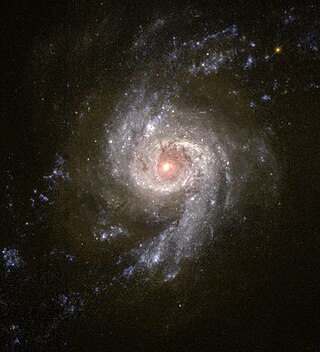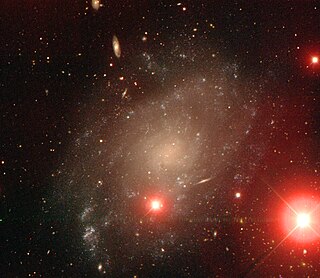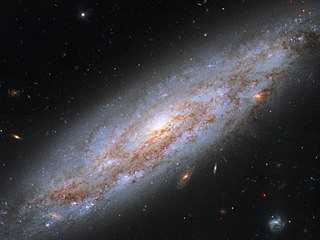
NGC 1705 is a peculiar lenticular galaxy and a blue compact dwarf galaxy (BCD) in the southern constellation of Pictor, positioned less than a degree to the east of Iota Pictoris, and is undergoing a starburst. With an apparent visual magnitude of 12.6 it requires a telescope to observe. It is estimated to be approximately 17 million light-years from the Earth, and is a member of the Dorado Group.

NGC 2787 is a barred lenticular galaxy approximately 24 million light-years away in the northern constellation of Ursa Major. It was discovered on December 3, 1788 by German-born astronomer William Herschel. J. L. E. Dreyer described it as, "bright, pretty large, a little extended 90°, much brighter middle, mottled but not resolved, very small (faint) star involved to the southeast". The visible galaxy has an angular size of 2.5 × 1.5 arcminutes or 3.24 × 1.81 arcminutes and an apparent visual magnitude of 11.8.

NGC 3310 is a grand design spiral galaxy in the constellation Ursa Major. It is a starburst galaxy and it is likely that NGC 3310 collided with one of its satellite galaxies about 100 million years ago, triggering widespread star formation. It is thought to be located approximately 46 million light-years away from the Earth, and is thought to be about 22,000 light-years wide.

NGC 4194, the Medusa merger, is a galaxy merger in the constellation Ursa Major about 128 million light-years (39.1 Mpc) away. It was discovered on April 2, 1791 by German-British astronomer William Herschel. Due to its disturbed appearance, it is object 160 in Halton Arp's 1966 Atlas of Peculiar Galaxies.

NGC 4605 is a dwarf barred spiral galaxy in the constellation Ursa Major, located at a distance of 18.1 ± 0.3 megalight-years from the Milky Way. Physically it is similar in size and in B-band absolute magnitude to the Large Magellanic Cloud. It is a member of the M81 Galaxy Group, along with Messier 81 and Messier 101.

NGC 5962 is a spiral galaxy in the equatorial constellation of Serpens Caput. It was discovered by the Anglo-German astronomer William Herschel on March 21, 1784. The NGC 5962 galaxy is located at a distance of 120 million light years and is receding with a heliocentric radial velocity of 1,957 km/s. It is the brightest member of the eponymously-named NGC 5962 group, which overlaps with the nearby NGC 5970 group; the two groups may be gravitationally bound.

NGC 4051 is an intermediate spiral galaxy in the constellation of Ursa Major. It was discovered on 6 February 1788 by John Herschel.

NGC 3539 is a lenticular galaxy in the constellation Ursa Major. It was discovered in April 1831 by John Herschel. It is a member of the galaxy cluster Abell 1185.

NGC 45 is a low surface brightness spiral galaxy in the equatorial constellation of Cetus. It was discovered on 11 November 1835 by the English astronomer John Herschel. The galaxy is located at a distance of 22 million light years and is receding with a heliocentric radial velocity of 466 km/s. It is located in the vicinity of the Sculptor Group, but is most likely a background galaxy.

NGC 4102 is an intermediate barred spiral galaxy located in the northern constellation of Ursa Major. It is visible in a small telescope and has an apparent visual magnitude of 11.2. The galaxy was discovered April 12, 1789 by William Herschel. J. L. E. Dreyer described it as "bright, pretty small, round, brighter middle and bright nucleus". This galaxy is located at a distance of 60 million light years and is receding with a heliocentric radial velocity of 837 km/s. It is a member of the Ursa Major group of galaxies.

NGC 3610 is an elliptical galaxy in the constellation Ursa Major. It was discovered on 8 April 1793 by German-British astronomer William Herschel. This galaxy is located at a distance of 106 million light-years (32.5 Mpc) from the Milky Way, and is receding with a galacto-centric radial velocity of 1,819 km/s.

NGC 2992 is a Seyfert galaxy located 103 million light years distant in the equatorial constellation of Hydra. It was discovered in 1785 by Anglo-German astronomer William Herschel.

NGC 3972 is a spiral galaxy located in the northern constellation of Ursa Major. It was discovered by William Herschel on April 14, 1789. This galaxy is located 66 million light years away and is receding with a heliocentric radial velocity of 846 km/s. It is a member of the NGC 3992 Group of galaxies.

NGC 2998 is a barred spiral galaxy located in the constellation Ursa Major. It is 195 million light-years away from the Earth. It is an intermediate spiral galaxy. Its stellar mass is about that of the Milky Way.

NGC 4561 is a barred spiral galaxy in the constellation Coma Berenices. It was discovered by German-British astronomer William Herschel on April 13, 1784. This galaxy is located at a distance of 82 ± 14 million light-years (25.2 ± 4.3 Mpc) from the Milky Way, and is a member of the Virgo Cluster of galaxies. It is 13th magnitude with an angular size of 1.5′.

NGC 3898 is a spiral galaxy in the constellation Ursa Major that was discovered by William Herschel on April 14, 1789. It is positioned 1.5° northwest of NGC 3998 and is barely visible in a small telescope. The galaxy has an apparent visual magnitude of 10.7 and an angular size of 3.3′ × 1.5′. It is located at a distance of 72 ± 6 million light-years (22.08 ± 1.79 Mpc) from the Milky Way, and is receding with a heliocentric radial velocity of 1,142.7±13.9 km/s.

NGC 3175 is a spiral galaxy located in the far eastern part of the southern constellation of Antlia at an approximate distance of 54 million light-years. NGC 3175 was discovered on March 30, 1835 by English astronomer John Herschel, whose notes described it as, "considerably bright, large, much extended NE-SW, very gradually little brighter middle". This galaxy is the namesake of the NGC 3175 group of galaxies, which includes the spiral galaxy NGC 3137.

NGC 2950 is a lenticular galaxy in the northern constellation of Ursa Major, about 50 million light years from the Milky Way and receding with a heliocentric radial velocity of 1,329 km/s. It was discovered in 1790 by the Anglo-German astronomer William Herschel. NGC 2950 is a field galaxy, it is not part of a galaxy cluster or galaxy group, and thus is gravitationally isolated. Nine certain and four possible dwarf galaxies have been identified around NGC 2950.

NGC 3619 is an unbarred lenticular galaxy located in the constellation Ursa Major. It was discovered by the astronomer William Herschel on March 18, 1790.

NGC 4123 is a modest-sized, strongly-barred spiral galaxy located 75 million light-years away in the equatorial constellation of Virgo. It was discovered February 25, 1784 by William Herschel. This is a member of the Virgo cluster, and it belongs to a group of three galaxies. A companion galaxy, NGC 4116, lies at an angular separation of 14′ to the southwest. There is no indication of an interaction between the two galaxies. The third member of the group is NGC 4179.























